Saltwater fishing is a thrilling and rewarding activity that requires specific gear to ensure success and safety.
Whether you’re a beginner or an experienced angler, having the right equipment is essential to catching your target fish and enjoying your time on the water.
In this comprehensive guide, we’ll discuss the essential saltwater fishing gear that every angler should have in their tackle box.
From rods and reels to bait and hooks, we’ll cover everything you need to know to get started and improve your skills.

If you’re looking to explore the world of Salt water Fishing, our latest blog post on what is saltwater fishing is a must-read for anyone curious about this exciting and challenging sport.
Rods and Reels for Saltwater Fishing
When it comes to saltwater fishing, choosing the right rod and reel is crucial to your success.
The right combination of length, power, action, size, and material can mean the difference between a successful catch and going home empty-handed.
How Does Length Affect a Fishing Rod?
First, consider the length of the rod. Longer rods are better suited for casting longer distances, while shorter rods are better for more precise casting in close quarters.
The power of the rod is also important and should be matched to the size of the fish you’re targeting.
Lighter power rods are better for smaller fish, while heavier power rods can handle larger fish.
What is The Action of The Rod?
The action of the rod refers to how much the rod bends when under pressure from a fish.
Faster action rods bend less and are better for quick hook sets, while slower action rods bend more and are better for fighting big fish.
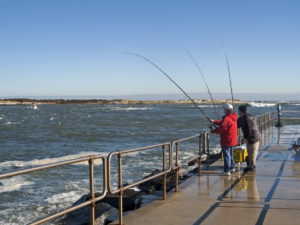
How to Pick The Right Action of The Rod for Saltwater Fishing
It’s important to pick the right action of the rod for fishing because it affects the sensitivity, casting distance, and hook setting power of the rod.
Choosing the right action of the rod is crucial for different types of saltwater fishing because it can make or break your fishing experience.
Let’s take a look at how to pick the right action of the rod for different types of saltwater fishing.
Fast Action
Fast action rods have a stiffer blank, which means they don’t bend much at the tip.
These rods are ideal for targeting larger species such as tuna, marlin, and sailfish, where you need to make long casts and set the hook quickly.
Medium Action
Medium action rods have a more flexible blank than fast action rods, which means they bend more towards the middle of the rod.
These rods are ideal for targeting species such as snook, redfish, and speckled trout, where you need a more sensitive rod to feel the bites and make accurate casts.
Slow Action
Slow action rods have the most flexible blank, which means they bend all the way down to the handle.
These rods are ideal for targeting smaller species such as panfish, trout, and bass, where you need to finesse the fish to bite and don’t need a lot of casting distance.
When selecting the right action of the rod for saltwater fishing, it’s important to consider the weight of the lure, the type of fishing line, and the technique you plan to use.
For example, if you’re using a heavy lure or fishing in strong currents, you’ll need a fast action rod to provide the necessary power and control.
On the other hand, if you’re using a light lure or fishing in calm waters, a slow action rod will provide the sensitivity and finesse you need.
Picking the right action of the rod is essential for successful saltwater fishing.
By understanding the different types of action and matching them to the species, fishing conditions, and techniques, you’ll be able to select the perfect rod for your next saltwater fishing adventure.
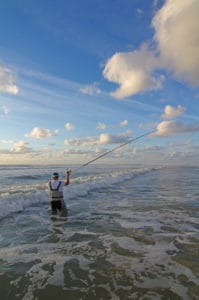
How to Pick The Right Length of Rod for Saltwater Fishing?
When it comes to selecting the right length of rod for saltwater fishing, there are a few things to consider such as the type of fishing, the species you’re targeting, the weight of your lure or bait, and your personal preference.
Here are some guidelines on how to pick the right length of rod for different types of saltwater fishing:
- Surf Fishing: For surf fishing,a longer rod is generally preferred as it allows you to cast further and keep your line above the waves. Rods between 9 to 12 feet are suitable for this type of fishing.
- Inshore Fishing: Inshore fishing typically involves fishing in shallow waters for species such as redfish, snook, and trout. A shorter rod between 6 to 7 feet is appropriate for this type of fishing as it allows for greater accuracy and better control over your bait or lure.
- Offshore Fishing: Offshore fishing involves targeting larger species such as tuna, marlin, and shark in deep waters. A longer rod between 7 to 10 feet is suitable for this type of fishing as it provides the necessary leverage to reel in big fish and withstand the pressure of deep water fishing.
- Bottom Fishing: Bottom fishing involves fishing on the bottom of the ocean for species such as grouper and snapper. A rod between 6 to 8 feet is ideal for this type of fishing as it allows for better sensitivity and control when fishing in deeper waters.
In addition to the type of fishing, the weight of your lure or bait will also influence your rod selection.
Heavier lures or baits will require a heavier and longer rod while lighter lures or baits will require a lighter and shorter rod.
Ultimately, the right length of rod will depend on your personal preference, fishing style, and the species you’re targeting.
It’s always a good idea to consult with experienced anglers or fishing professionals for advice on selecting the right rod for your specific needs.
How to Pick the Right Sized Reel?
Size is another important factor to consider, as a larger reel can hold more line and provide more power when reeling in a fish.
When it comes to saltwater fishing, having the right reel is essential for a successful and enjoyable experience.
However, choosing the right size reel can be a daunting task, especially for beginners.
But fear not,we’ll take you through everything you need to know about selecting the right sized reel for your saltwater fishing rod.
First things first, it’s important to understand that there are different types of saltwater fishing, and each requires a specific type and size of reel. Let’s take a look at the different types of saltwater fishing and the corresponding reel sizes.
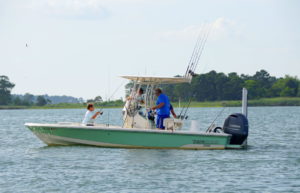
Inshore Fishing Reel
Inshore fishing refers to fishing in shallow waters close to the shore, such as estuaries, bays, and flats.
For this type of fishing, you’ll need a smaller and lighter reel, typically in the 1000 to 4000 size range.
These reels are designed to handle lighter lines and lures and are ideal for targeting species such as redfish, speckled trout, and snook.
Offshore Fishing Reel
Offshore fishing refers to fishing in deeper waters farther from the shore, such as the open ocean or reefs.
For this type of fishing, you’ll need a larger and heavier reel, typically in the 5000 to 8000 size range.
These reels are designed to handle heavier lines and lures and are ideal for targeting larger species such as tuna, marlin, and sailfish.
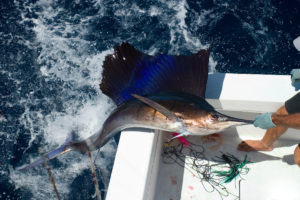
Surf Fishing Reel
Surf fishing refers to fishing from the shoreline, typically on beaches or jetties.
For this type of fishing, you’ll need a medium to a large-sized reel, typically in the 4000 to 6000 size range.
These reels are designed to handle long casts and heavy surf conditions and are ideal for targeting species such as striped bass, bluefish, and sharks.
What Size Reel for Your Saltwater Fishing Rod?
Now that you know the different types of saltwater fishing and the corresponding reel sizes let’s talk about how to pick the right sized reel for your saltwater fishing rod.
The general rule of thumb is to match the size of the reel to the size of the rod.
So, if you have a 7-foot rod, you’ll want to pair it with a reel in the 3000 to 4000 size range for inshore fishing, a 5000 to 6000 size range for surf fishing, and a 6000 to 8000 size range for offshore fishing.
However, it’s important to note that this is just a general guideline, and other factors such as the weight of the lure and the strength of the fishing line also play a role in selecting the right sized reel.

For example, if you’re using a heavier lure or fishing in stronger currents, you may need a larger and heavier reel to handle the added weight and resistance.
Selecting the right sized reel for your saltwater fishing rod comes down to understanding the different types of saltwater fishing, matching the size of the reel to the size of the rod, and taking into account other factors such as lure weight and fishing line strength.
With this knowledge in hand, you’ll be well on your way to choosing the perfect reel for your next saltwater fishing adventure.
The Importance of Quality Material for a Rod and Reel
Consider the material of the rod and reel. Graphite and fiberglass are popular choices for saltwater rods, as they are strong and durable.
For reels, consider the quality of the drag system, as this can greatly affect your ability to successfully reel in a fish.
The Best Rod and Reel combos for Saltwater Fishing
As for specific models and brands, popular choices for beginners include the Penn Battle II spinning reel and Ugly Stik GX2 rod.
While experienced anglers may prefer the Shimano Stella SW spinning reel and G. Loomis NRX rod.
It’s important to do your research and find the best rod and reel for your specific needs and budget.
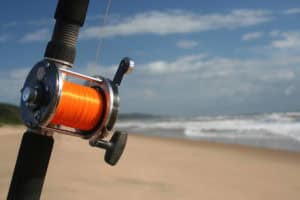
Line and Leader for Saltwater Fishing
Having the right line and leader for saltwater fishing is essential to handle the weight and power of big fish and prevent line breakage.
There are three main types of fishing lines: monofilament, fluorocarbon, and braided, and each has its own advantages and disadvantages.
Monofilament line is a single strand of nylon and is the most popular and versatile line for saltwater fishing. It’s easy to handle, inexpensive, and comes in a wide range of strengths and diameters.
Fluorocarbon line is similar to monofilament but is denser and more resistant to abrasion and UV light, making it a good choice for clear water and spooky fish.
Braided line is made of multiple strands of synthetic fibers and is the strongest of the three, making it ideal for fishing in heavy cover and for targeting big game fish.
How to Choose the Right Fishing Line for Saltwater Fishing
When it comes to strength, choose a line that matches the weight of the fish you’re targeting.
A general rule of thumb is to use a line that has a breaking strength of at least twice the weight of the fish.
For example, if you’re targeting a 20-pound fish, use a line with a breaking strength of at least 40 pounds.
Leaders are also an important part of your fishing setup. A leader is a length of line that’s attached to the end of your main line and is used to prevent the fish from seeing the line and to add extra strength to the setup.
There are two main types of leaders: monofilament and fluorocarbon.
Monofilament leaders are good for general saltwater fishing and are less visible to fish, while fluorocarbon leaders are more abrasion-resistant and are better for targeting bigger fish.
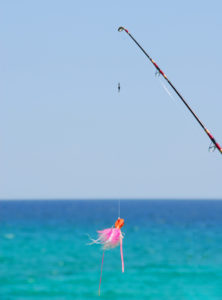
Leader
When tying a leader to your main line, use a strong knot such as the double uni knot or the Albright knot.
The size of the leader should match the strength of your main line, and the length of the leader should be at least twice the length of the fish you’re targeting.
Choosing the right line and leader for saltwater fishing is crucial to your success. Consider the type and strength of the line, as well as the type and length of the leader, and tie them together with a strong knot for maximum effectiveness.
Terminal Tackle for Saltwater Fishing
The terminal tackle is the final gear that connects to the end of your fishing line, and it includes hooks, swivels, and sinkers.
Choosing the right terminal tackle is important because it can affect your chances of catching fish and the overall success of your fishing trip.
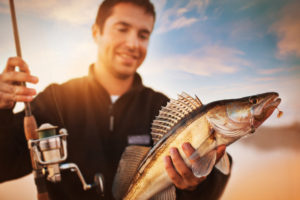
Hooks
Hooks come in different sizes, shapes, and materials, and it’s important to choose the right hook for the fish species you’re targeting.
Hooks range from small size 30 for catching small fish to larger size 20/0 for catching sharks and other big game fish. The shape and barb of the hook can also make a difference in your success rate.
Circle hooks, for example, are designed to hook the fish in the corner of the mouth, while J-hooks can be more versatile for different fishing scenarios.
It’s also important to consider the material of the hook, with options including stainless steel, bronze, and high-carbon steel.
Swivels
Swivels are small, metal connectors that attach to your line and prevent line twist caused by the rotation of the bait or lure.
Using a swivel can help keep your line from tangling and improve your chances of catching fish. When selecting a swivel, consider the size and strength of your line and choose a swivel that matches.
Barrel swivels are the most common type and come in a range of sizes and strengths.
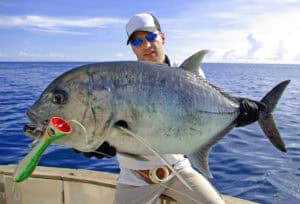
Sinkers
Sinkers are weights that are attached to the line to help it sink to the desired depth.
Different types of sinkers are designed for different purposes, including pyramid sinkers, bullet sinkers, split-shot sinkers, and egg sinkers.
The weight of the sinker should be chosen based on the depth and current of the water you’re fishing in.
It’s also important to consider the shape of the sinker, with options including round, oval, and teardrop.
Importance of the Right Tackle
Choosing the right terminal tackle is important for catching fish and preventing line tangles or breakage.
Consider the species of fish you’re targeting, the water conditions, and the size and strength of your line when selecting hooks, swivels, and sinkers.
With the right terminal tackle, you can increase your chances of a successful and enjoyable saltwater fishing trip.
Lures and Baits for Saltwater Fishing
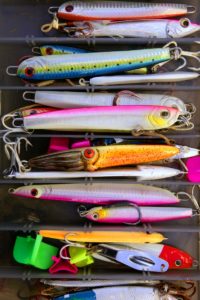
Hard baits
Hard baits are typically made of plastic or wood and come in different shapes and sizes.
They are designed to imitate the movement and appearance of small fish and can be effective for catching predatory fish.
Some popular hard baits for saltwater fishing include crankbaits, jerkbaits, and topwater plugs.
They can be retrieved in different ways, such as a steady retrieve or a twitching motion, and should be chosen based on the type of fish you’re targeting.
Hard baits have the advantage of being durable and can withstand repeated use.
Soft baits
Soft baits are typically made of soft plastic and come in different shapes, colors, and sizes.
They are versatile and can be used in different fishing scenarios, such as jigging or drop-shotting.
Some popular soft baits for saltwater fishing include swimbaits, grubs, and shrimp.
They can be rigged with a hook or jighead and retrieved in different ways to imitate the movement of prey. Soft baits have the advantage of being more lifelike and can attract fish more effectively.
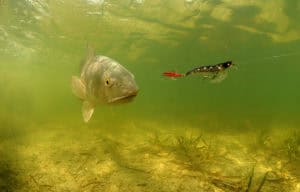
Live baits
Live baits include any live or dead organism used as bait, such as shrimp, squid, or fish. They can be effective for attracting fish that are feeding on live prey.
Some popular live baits for saltwater fishing include live shrimp, mullet, and pilchards. They should be chosen based on the fish species you’re targeting and the water conditions.
Live baits have the advantage of being the most natural and can attract fish more readily.
To keep your live bait alive and healthy during a fishing trip, it’s important to provide them with proper oxygenation and water circulation.
One of the best portable live wells on the market is the Engel 19qt Live Bait Cooler Box with 2nd Gen 2-Speed Portable Aerator Pump.
Selecting the Right Lure or Bait for Saltwater Fishing
When selecting a lure or bait, it is essential to consider the size, shape, and color, as well as the fishing technique and the fish species you’re targeting.
It’s also important to match the size of the hook or jighead to the size of the lure or bait. For example, larger baits typically require larger hooks to ensure a secure hold.
Some popular and effective lures and baits for saltwater fishing include the Rapala X-Rap, Z-Man MinnowZ, and live shrimp.
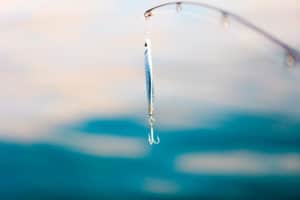
Use the Right Technique when Salt Water Fishing
It’s also essential to use your lure and bait effectively. For example, the retrieval speed and technique can affect the lure or bait’s action and attractiveness to fish.
Experimenting with different techniques and using a variety of lures and baits can help you determine what works best for you and the fish species you’re targeting.
Using the right lure or bait is essential to attract and catch fish when saltwater fishing.
Understanding the benefits and drawbacks of each type of lure or bait and how to use them effectively can improve your chances of success.
Remember to experiment and have fun while fishing to maximize your experience.
Looking to improve your saltwater fishing skills and catch more fish on your next outing? Check out our latest blog post on saltwater fishing tips for some practical and effective advice that will help you reel in the big ones
Safety Gear for Saltwater Fishing
When it comes to fishing in saltwater, safety should always be a top priority.
As with any outdoor activity, there are inherent risks involved, and it’s essential to take steps to minimize those risks and ensure that you and your fellow anglers stay safe on the water.
One of the most critical pieces of safety gear that every angler should have is a personal flotation device (PFD).
A PFD is designed to keep you afloat in the water if you fall overboard or experience any other type of mishap. It’s important to choose a PFD that fits well and is appropriate for the type of fishing you’ll be doing.
In addition to a PFD, it’s also a good idea to carry a whistle or air horn. These devices can be used to signal for help in an emergency situation, and they’re an essential part of any angler’s safety kit.
Another essential item to have on hand is a first aid kit. Accidents can happen when you’re fishing, and having a well-stocked first aid kit can help you deal with minor injuries or emergencies until you can get more advanced medical attention.
Be sure to include items like bandages, antiseptic, and any medications you may need.
Beyond these basic safety items, there are other steps you can take to ensure your safety when fishing in saltwater.
For example, it’s essential to wear appropriate clothing and footwear.
This may include things like a hat, sunglasses, sunscreen, water-resistant shoes, and bug spray that will help you keep your footing on wet surfaces.
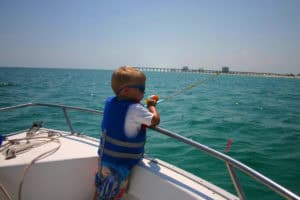
You should also check the weather and tides before heading out on the water. This will help you avoid dangerous conditions that could put you and your fellow anglers at risk.
If the weather is looking iffy, it’s often better to err on the side of caution and postpone your trip until conditions improve.
Finally, be mindful of any potential dangers in the area where you’ll be fishing. This may include things like strong currents, rocky outcroppings, or areas with lots of boat traffic.
By staying aware of your surroundings and taking appropriate precautions, you can help ensure that your fishing trip is a safe and enjoyable experience for everyone involved.
Have the Right Cooking Equipment
Let’s not forget the importance of catching and cooking your own fish! Not only is it a rewarding experience, but it also guarantees the freshest and highest quality fish for your meal.
When it comes to cooking fish, having the right equipment is key.
For deep frying, a deep fryer or a heavy-bottomed pot and a thermometer will ensure perfectly cooked and crispy fish.
If you’re a fan of crispy and golden-brown fried fish, then you won’t want to miss our latest blog post on how to fry fish, where we teach you how to achieve perfectly cooked and deliciously crispy fish every time.

Baking fish requires an oven-safe dish, parchment paper, and a meat thermometer to monitor the temperature for perfectly cooked fish every time.
For grilling, a sturdy grill basket, tongs, and a good-quality grill are essential to get those gorgeous grill marks and smoky flavor.
So, whether you’re an experienced angler or just starting out, investing in quality cooking equipment and catching your own fish is the way to go for a delicious and unforgettable seafood feast.
Conclusion
Having the right gear is essential to successful and enjoyable saltwater fishing.
Whether you’re a beginner or an experienced angler, this comprehensive guide has provided you with the essential knowledge and recommendations for rods and reels, line and leader, terminal tackle, lures and baits, and safety gear.
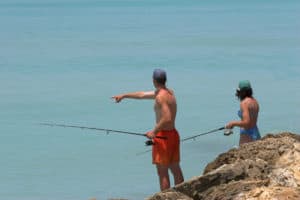
By following these tips and using the recommended gear, you can increase your chances of catching your target fish and having a memorable time on the water.
Remember to always follow local regulations, practice responsible fishing, and respect the environment and other anglers. Happy fishing!
